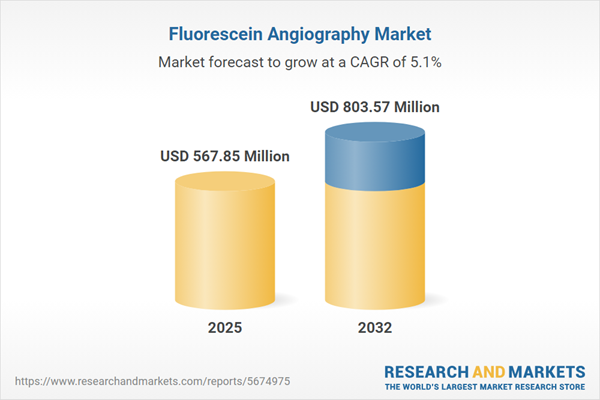Speak directly to the analyst to clarify any post sales queries you may have.
The fluorescein angiography market is transforming retinal diagnostics, enabling healthcare organizations to advance clinical throughput, make better-informed decisions, and optimize care delivery across diverse ophthalmic environments. Senior executives are leveraging these innovations to streamline patient pathways and elevate operational standards.
Market Snapshot: Strategic Overview of the Fluorescein Angiography Market
Demonstrating resilient expansion, the global fluorescein angiography market is projected to grow from USD 540.00 million in 2024 to USD 567.85 million in 2025, ultimately reaching USD 803.57 million by 2032 at a CAGR of 5.09%.
Market growth is driven by the increasing demand for advanced retinal diagnostics and seamless adoption of digital imaging platforms, as well as the rising prevalence of chronic retinal pathologies. Healthcare leaders are prioritizing interoperable and secure imaging systems to support sophisticated data management, remain responsive to evolving regulations, and further clinical outcomes across departments.Scope & Segmentation of the Fluorescein Angiography Market
- Product Types: Diagnostic consumables, including fluorescein dyes, syringes, and needles, are fundamental for both routine assessments and urgent retinal interventions, enabling consistent patient monitoring and uninterrupted care in both clinics and hospital settings.
- Imaging Equipment: Fundus cameras, wide-field cameras, and scanning laser ophthalmoscopes support comprehensive examination of retinal structures, enhancing the accuracy of clinical decisions and enabling providers to deliver earlier, more targeted care interventions.
- Imaging Technologies: Analog systems maintain relevance in areas with limited resources, while digital platforms strengthen the efficiency of contemporary imaging workflows, enabling rapid result sharing and supporting cross-disciplinary diagnostic collaboration.
- Procedure Types: Applications cover early screening, definitive diagnosis, and long-term disease management, providing healthcare organizations flexibility to launch targeted interventions and population health initiatives across a range of retinal diseases.
- End Users: Hospitals, ambulatory surgical centers, diagnostic centers, and ophthalmology clinics collectively expand access to precision imaging, offering comprehensive services to diverse and growing patient populations.
- Applications: Technologies in this sector are essential for detecting and monitoring age-related macular degeneration, diabetic retinopathy, uveitis, and retinal vascular occlusions, promoting proactive management and the evolution of long-term care pathways.
- Regional Markets: Americas, Europe, Middle East & Africa, and Asia-Pacific each exhibit distinctive dynamics in regulation, reimbursement, and technology adoption, with regional characteristics shaping procurement strategies and influencing investments at the institutional level.
- Key Companies Covered: Industry innovation and competitive standards are set by Carl Zeiss AG, Optomed PLC, Topcon Corporation, Nidek Co., Ltd., Chongqing Vision Star Optical Co., Ltd., epipole Ltd, Baxter International Inc., Medimaging Integrated Solution, Inc., Shanghai Canton Optics Equipment Co., Ltd., and Optitech Eyecare, each contributing to global technology development and product distribution benchmarks.
Key Takeaways for Senior Leaders
- Digital imaging workflows create opportunities for collaborative and timely decision-making, ensuring secure and streamlined data flow across extensive healthcare networks.
- Building strong supplier and vendor relationships enhances organizational resilience and streamlines compliance with shifting regulatory and quality standards.
- Imaging platform analytics facilitate earlier identification of retinal disorders, supporting individualized patient management and strengthening ongoing engagement.
- Device manufacturers, software companies, and AI innovators are collaborating to develop standardized, adaptable workflows, positioning organizations to meet contemporary healthcare demands.
- Adapting strategies in response to regulatory changes is increasingly important for successful technology integration and reduction of entry barriers in competitive markets.
- Continuous workforce development and operational enhancements are crucial to successfully adopting new platforms and maintaining high performance as digital solutions are integrated into daily practice.
Tariff Impact: Navigating Cost Pressures in Imaging
Recent tariff policy changes in the United States have increased acquisition costs for imported ophthalmic diagnostic equipment and consumables. In response, healthcare organizations are broadening sourcing strategies and renegotiating procurement agreements to ensure supply chain reliability. Maintaining strong relationships with reputable vendors and enforcing strict quality management procedures are vital to limit service interruptions and enhance organizational stability in fluctuating market environments.
Methodology & Data Sources
This market assessment is based on structured interviews with senior healthcare executives, clinical practitioners, supply chain managers, and regulatory advisors. All qualitative and quantitative insights have been validated against industry reports and peer-reviewed publications, ensuring relevance and reliability for executive decision-making.
Why This Report Matters
- Decision-makers gain insights into strategic investment and resource optimization within the diagnostic imaging sector.
- Understanding of key regulatory, procurement, and technology trends supports flexible, informed risk management and operational advancement.
- Guidance equips organizations to pursue technological growth, strengthen quality initiatives, and extend their reach in patient care excellence.
Conclusion
This report positions healthcare leaders to drive innovation, prioritize institutional agility, and achieve consistent care excellence through informed technology investment and process optimization.
Additional Product Information:
- Purchase of this report includes 1 year online access with quarterly updates.
- This report can be updated on request. Please contact our Customer Experience team using the Ask a Question widget on our website.
Table of Contents
3. Executive Summary
4. Market Overview
7. Cumulative Impact of Artificial Intelligence 2025
Companies Mentioned
The companies profiled in this Fluorescein Angiography market report include:- Carl Zeiss AG
- Optomed PLC
- Topcon Corporation
- Nidek Co., Ltd.
- Chongqing Vision Star Optical Co.,Ltd.
- epipole Ltd
- Baxter International Inc.
- Medimaging Integrated Solution, Inc.
- Shanghai Canton Optics Equipment Co., Ltd.
- Optitech Eyecare
Table Information
| Report Attribute | Details |
|---|---|
| No. of Pages | 190 |
| Published | November 2025 |
| Forecast Period | 2025 - 2032 |
| Estimated Market Value ( USD | $ 567.85 Million |
| Forecasted Market Value ( USD | $ 803.57 Million |
| Compound Annual Growth Rate | 5.0% |
| Regions Covered | Global |
| No. of Companies Mentioned | 11 |









